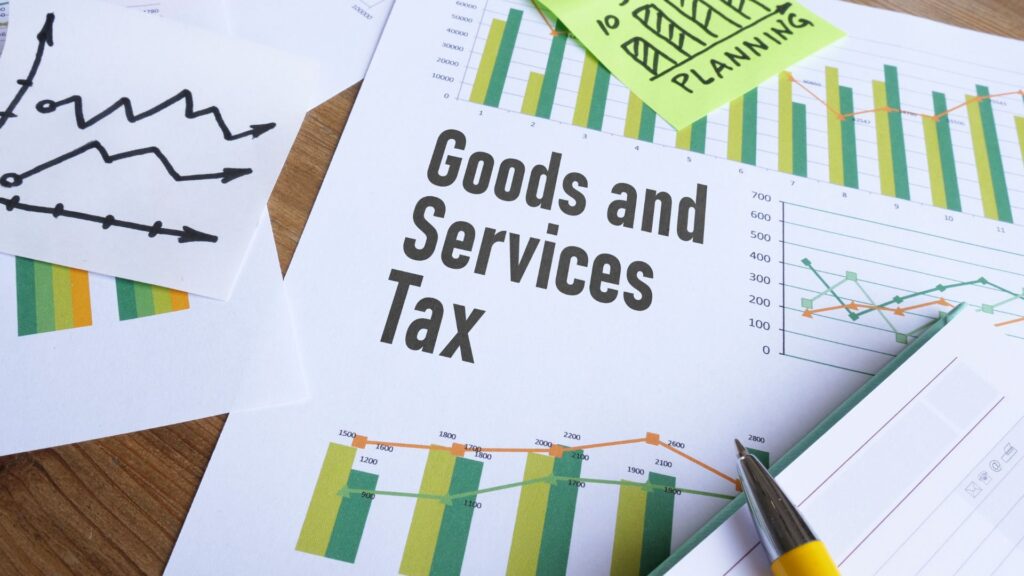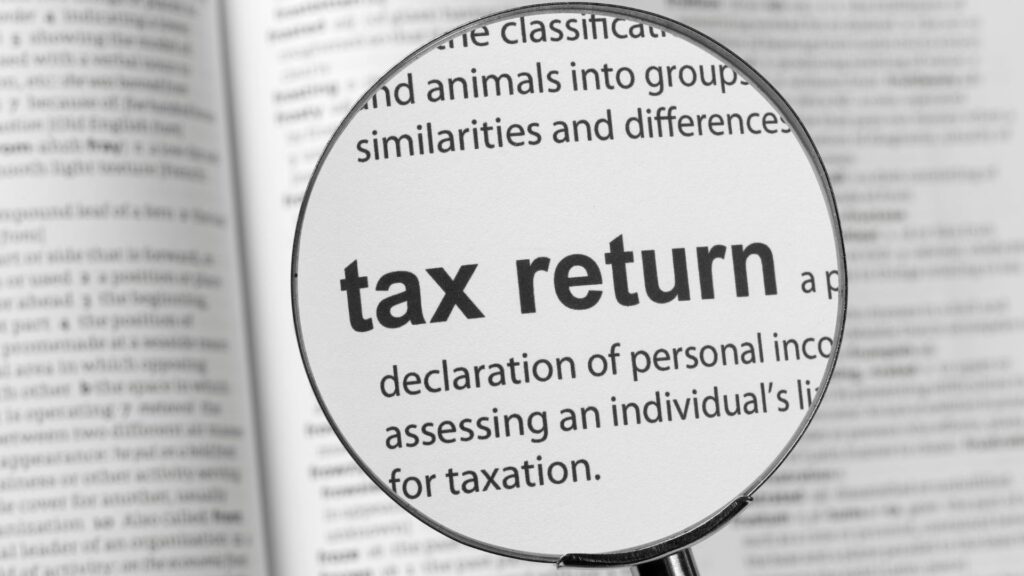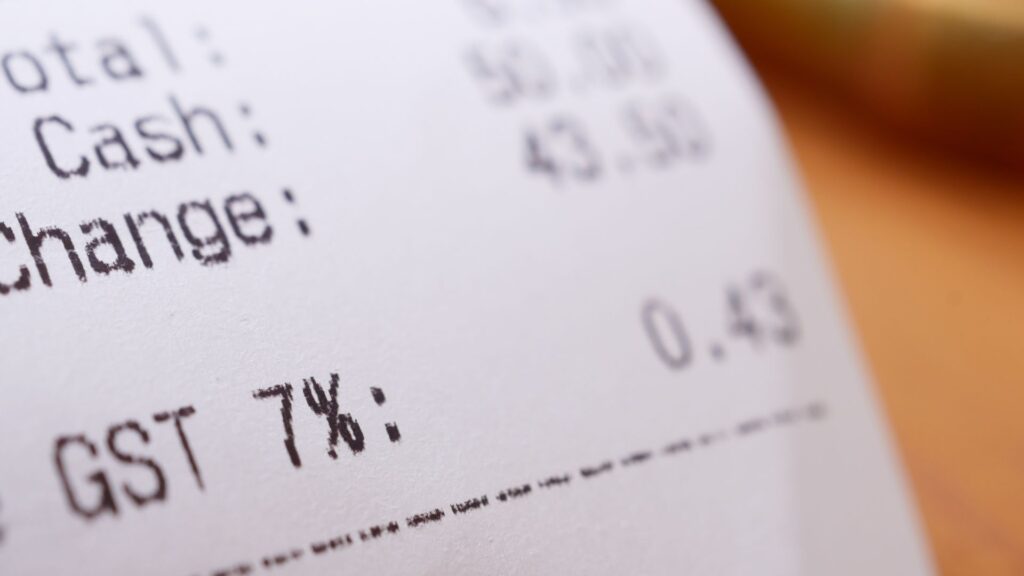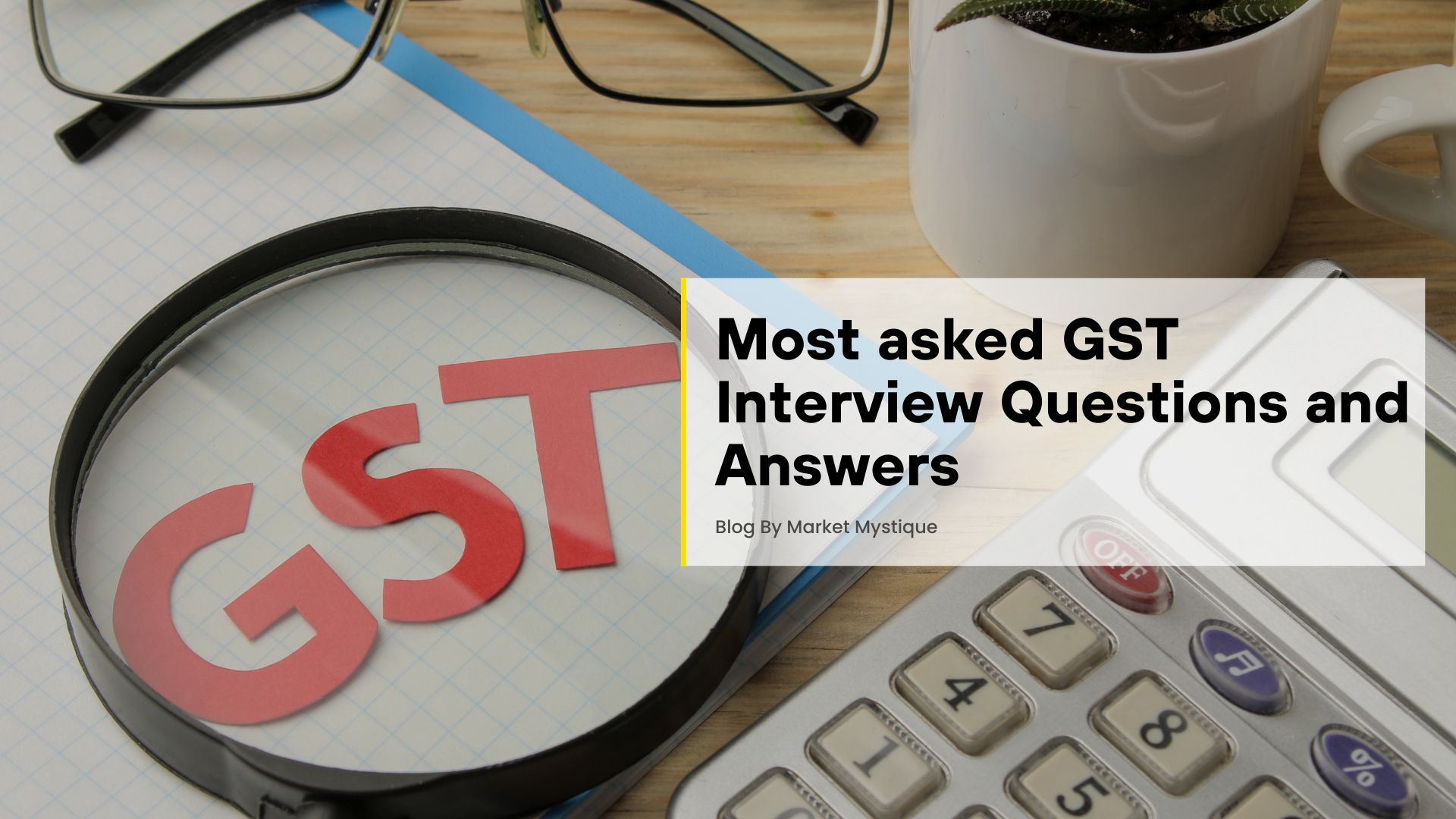Are you looking to break into the field of taxation and accounting? You may be a finance or accounting graduate preparing for a GST interview. We get it—interviews can be both exciting and nerve-wracking. Preparing for a GST interview means understanding the relevant rules and practicing common interview questions and answers.
This preparation can help you shine in the interview and boost your confidence. To help you out, we’ve put together a list of the top GST interview questions along with their answers.
Dive into GST Interview Questions and Answers
Here’s a wide list of important GST interview questions and answers for accountants and Tally operators. These questions can also benefit candidates working in accounting and finance.

Question 1. What are the different types of GST?
Answer: GST is categorized into four main types:
- Central GST (CGST): Applied on transactions within a single state, with the revenue going to the central government.
- State GST (SGST): Also applied to intra-state transactions, with the revenue going to the respective state government.
- Integrated GST (IGST): Applied on inter-state transactions and imports, with the revenue going to the central government.
- Union Territory GST (UTGST): Similar to SGST but applies in union territories without a state legislature.
Question 2. What is GST and why was it implemented?
Answer: GST, or Goods and Services Tax, is a comprehensive, multi-stage, destination-based tax that is levied on every value addition. It was implemented to replace multiple indirect taxes like VAT, service tax, and excise duty with a single tax, simplifying the tax structure and making it more transparent. GST aims to eliminate the cascading effect of taxes and promote a common national market.
Question 3. Can you elaborate on the GST compliance guidelines for firms in India and how the company ensures compliance?
To ensure GST compliance for our company in India, we follow a structured approach that includes registering for GST to obtain a unique GSTIN, consistently filing GST returns on time, making timely GST payments, and maintaining accurate records and paperwork. We’ve implemented several key practices to uphold compliance: regular staff training on GST rules and procedures, frequent reviews and audits to promptly address any compliance issues, and collaboration with external advisors when necessary. Additionally, we have robust systems and processes in place to track and manage GST-related transactions, input tax credits, and liabilities, ensuring that we stay compliant and avoid any potential issues.

Question 4. How do you file GST returns?
Answer: GST returns can be filed online through the GST portal. Different types of returns need to be filed depending on the nature of the business, such as GSTR-1 for sales, GSTR-3B for summary returns, and GSTR-9 for annual returns. Accurate and timely filing of returns is crucial to avoid penalties and ensure compliance.
Question 5. What is a GST invoice, and what are its key components?
Answer: A GST invoice is a document that a supplier issues to the recipient of goods or services. It must include the following key components:
- Supplier’s name, address, and GSTIN
- Recipient’s name, address, and GSTIN
- Invoice number and date
- Description of goods/services
- Quantity and unit
- Taxable value
- GST rate and amount
- Total amount payable
Question 6. What is the reverse charge mechanism in GST?
Answer: Under the reverse charge mechanism, the recipient of goods or services is liable to pay GST instead of the supplier. This mechanism applies in specific cases, such as when dealing with unregistered suppliers or certain notified supplies. It aims to bring unorganized sectors under the GST net and ensure tax compliance.
Question 7. What recent changes or amendments have been made in GST?
Answer: GST laws are periodically updated to address various issues and improve the system. Recent changes include:
- E-invoicing: Mandatory for businesses with an annual turnover exceeding ₹50 crores.
- QRMP Scheme: Quarterly Return filing and Monthly Payment of taxes scheme for small taxpayers with turnover up to ₹5 crores.
- Amendments in ITC rules: Restrictions on availing ITC based on GSTR-2B.
These changes aim to simplify compliance and reduce the tax burden on small taxpayers.
Question 8. How does GST impact e-commerce businesses?
Answer: E-commerce businesses are subject to specific GST provisions. They must register for GST regardless of their turnover and are required to collect Tax Collected at Source (TCS) at a rate of 1% on the net value of taxable supplies. This TCS must be reported in the GSTR-8 return. Additionally, they need to ensure compliance with GST invoicing and return filing requirements.
Question 9. What are the penalties for non-compliance with GST regulations?
Answer: Penalties for non-compliance with GST regulations can be severe. They include:
- Late filing: A late fee of ₹50 per day (₹20 for NIL returns) is charged for each day of delay.
- Non-payment or short payment of tax: A penalty of 10% of the tax amount due (minimum ₹10,000) can be imposed.
- Fraud: A penalty of 100% of the tax amount due can be levied if there is an intention to evade tax.

Question 10. What is Input Tax Credit (ITC)?
Answer: Input Tax Credit (ITC) is a mechanism that allows businesses to reduce the tax they have paid on inputs (purchases) from the tax they have to pay on outputs (sales). For example, if a business has paid ₹100 as GST on purchases and needs to pay ₹150 as GST on sales, it can claim an ITC of ₹100 and pay only the net amount of ₹50.
Question 11. What is the composition scheme under GST?
Answer: The composition scheme is a simplified tax scheme for small taxpayers with a turnover of up to ₹1.5 crores (₹75 lakhs for certain states). Under this scheme, taxpayers can pay GST at a fixed rate on their turnover instead of the normal GST rates. The rates are:
- 1% for manufacturers and traders.
- 5% for restaurants.
- 6% for service providers (up to a turnover of ₹50 lakhs). This scheme reduces the compliance burden by allowing taxpayers to file quarterly returns instead of monthly ones.
Question 12. What’s the Difference Between CGST and SGST in India?
In India, there are two main parts of GST: SGST (State GST) and CGST (Central GST). SGST is collected by the state, while CGST is collected by the central government. The GST collected is split between the state and central governments, and they are charged at the same rate.
Advanced GST Interview Questions and Answers for 2024
Are you aiming to break into the field of taxation and accounting, particularly focusing on GST? Whether you’re a fresh graduate or a professional seeking to transition, preparing thoroughly for a GST interview can set you apart. This guide will help you get ready with some advanced and frequently asked questions, ensuring you’re confident in both basic concepts and the latest changes.
Here’s an upgraded list of GST interview questions along with detailed answers, which will be helpful for accountants, finance professionals, and Tally operators.
Question 1. What is the GST framework, and how does it differ from the previous tax system?
Answer: The Goods and Services Tax (GST) is a comprehensive tax regime designed to subsume multiple indirect taxes like VAT, service tax, excise duty, and more. Unlike the previous system, GST is destination-based, ensuring that the tax is paid at the point of consumption rather than production. Key differences include:
- Cascading Effect: GST eliminates the cascading effect by allowing seamless input tax credit (ITC) across the supply chain.
- Uniformity: It replaces various state and central taxes, creating a single tax system across India, fostering a unified national market.
- Digitization: Filing returns, invoicing, and compliance processes are digitized, promoting transparency.
Question 2. Can you explain the concept of ‘Supply’ under GST?
Answer: Under GST, “Supply” is a broad concept and forms the taxable event. Supply includes the sale, transfer, barter, exchange, license, rental, lease, or disposal of goods and services for consideration, during the course of business. It also includes import of services, whether or not for business. Additionally, certain activities are considered supplies even if no consideration is involved, such as branch transfers, and supply to related persons.
Question 3. What is GST Composition Scheme and how is it different from the Regular Scheme?
Answer: The GST Composition Scheme is a simplified tax scheme designed for small taxpayers. Businesses with a turnover of up to ₹1.5 crores (₹75 lakhs in certain states) can opt for this scheme to pay tax at a lower, fixed rate on their turnover, without availing input tax credit (ITC).
Key differences from the Regular Scheme:
- Tax Rate: Under the Composition Scheme, the tax rates are 1% for manufacturers and traders, 5% for restaurants, and 6% for service providers with turnover up to ₹50 lakhs. In the Regular Scheme, businesses are taxed as per the applicable GST rates.
- Return Filing: Composition taxpayers need to file quarterly returns (CMP-08) compared to monthly returns in the Regular Scheme.
- ITC: Composition dealers cannot claim ITC, whereas regular taxpayers can claim ITC on eligible purchases.
Question 4. What are the different returns under GST, and how frequently should they be filed?
Answer: GST returns are specific to the type of taxpayer and the nature of the business. The main returns include:
- GSTR-1: Monthly or quarterly return detailing outward supplies (sales).
- GSTR-3B: Monthly summary return for reporting tax liability and payment.
- GSTR-9: Annual return that summarizes the details of all monthly/quarterly returns filed during the year.
- GSTR-2B: Auto-drafted statement for input tax credit available for the taxpayer.
- GSTR-4: Annual return for taxpayers under the Composition Scheme.
Filing frequency varies large businesses file monthly, while smaller businesses can opt for quarterly filing under the QRMP (Quarterly Return Monthly Payment) scheme.
Question 5. What are the recent changes in GST regarding e-invoicing and how does it affect businesses?
Answer: Recent amendments have made e-invoicing mandatory for businesses with an annual turnover exceeding ₹10 crores (as of 2023). E-invoicing requires businesses to generate invoices through the GST portal, which are validated by the Invoice Registration Portal (IRP) and assigned a unique Invoice Reference Number (IRN).
Impact on businesses:
- Automation: E-invoicing automates invoice generation, ensuring accuracy and reducing errors.
- Compliance: It strengthens GST compliance as invoices are auto-populated in GSTR-1, and ITC is reflected in GSTR-2B.
- Standardization: E-invoicing ensures that all invoices follow a uniform format, making it easier for audits and assessments.
Question 6. What are the key differences between the Input Tax Credit (ITC) and the Reverse Charge Mechanism (RCM)?
Answer: Input Tax Credit (ITC) allows businesses to reduce the tax they have paid on inputs (purchases) from the tax payable on their outputs (sales). ITC can only be claimed if the goods/services are used for business purposes and meet certain conditions, such as the supplier being registered and the recipient possessing a tax invoice.
Reverse Charge Mechanism (RCM), on the other hand, shifts the tax liability from the supplier to the recipient. Under RCM, the buyer (recipient) is responsible for paying GST directly to the government on specific notified goods/services or when purchasing from unregistered suppliers.
Question 7. How does the GST law address input tax credit mismatches?
Answer: The government has introduced several measures to address mismatches in input tax credit (ITC). Now, ITC can only be claimed based on invoices appearing in GSTR-2B, an auto-drafted statement reflecting the supplier’s sales invoices filed in GSTR-1. Any discrepancy between the two returns (GSTR-1 and GSTR-2B) may lead to the denial of ITC until the supplier rectifies the error. This ensures that ITC is only claimed on actual supplies.
Question 8. Can you explain GST on Works Contracts and how it differs from regular supply of goods and services?
Answer: A Works Contract is considered a composite supply under GST, typically involving the supply of both goods and services (such as construction, maintenance, or installation services). Unlike regular supplies, works contracts are treated as services under GST law, with a specific rate of 18%. Input tax credit can be availed for works contracts that are used for further business purposes but is restricted when it pertains to the construction of the immovable property.
Question 9. What are anti-profiteering measures under GST?
Answer: The anti-profiteering provisions under GST require that businesses pass on the benefit of reduced tax rates or input tax credits to consumers by reducing the prices of goods or services. Failure to comply may result in penalties, and the National Anti-Profiteering Authority (NAA) is responsible for investigating cases where businesses are found to be profiteering from reduced GST rates without passing the benefits to consumers.
Question 10. What is the difference between exempt, zero-rated, and nil-rated supplies under GST?
Answer:
- Exempt Supplies: Goods or services exempt from GST, meaning no tax is applicable, and no ITC can be claimed (e.g., healthcare, educational services).
- Zero-Rated Supplies: Primarily exports and supplies to SEZs. These are taxed at 0%, but input tax credit is allowed.
- Nil-Rated Supplies: Goods/services that attract 0% GST, with no input tax credit available (similar to exempt supplies but specifically listed).
Additional Tips for GST Interviews
- Stay Updated: GST laws are constantly evolving. Keep an eye on the latest notifications and changes introduced by the GST Council.
- Understand Practical Applications: Be ready to explain how GST applies to real-life business scenarios such as filing returns, claiming ITC, and dealing with audits.
- Prepare for Hypotheticals: Employers may ask scenario-based questions to test your practical knowledge. Practice responding to questions about compliance issues, tax evasion cases, and how you would handle incorrect filings.
With thorough preparation and a solid understanding of the key concepts outlined above, you’ll be ready to ace your GST interview.
Some common GST Interview Questions and Answers

Who needs to register for GST?
Answer: Any business whose aggregate turnover exceeds the threshold limit of ₹20 lakhs (₹10 lakhs for special category states) is required to register for GST. Additionally, certain businesses, such as those involved in inter-state trade, e-commerce operators, and those required to pay tax under the reverse charge mechanism, must register regardless of their turnover.
What are the Different GST Rates in India?
The GST (Goods and Services Tax) rates in India come in four categories: 5%, 12%, 18%, and 28%. The GST Council, which includes state and central finance ministers, decides these rates for different goods and services. Some items are either taxed at a lower rate or are exempt from GST altogether.
What is the significance of the HSN and SAC codes in GST?
Answer: HSN (Harmonized System of Nomenclature) and SAC (Services Accounting Code) are codes used to classify goods and services under GST. The HSN code is used for goods, and the SAC code is used for services.
Tips for Cracking GST Interviews
Preparing for the interview
- Research thoroughly: Understand the latest GST regulations and revisions.
- Practice mock interviews: Get comfortable with common interview questions.
- Stay updated: Follow GST news and updates to stay informed.
Common traps to avoid
- Lack of preparation: Not knowing the basics can be detrimental.
- Ignoring recent changes: Being unaware of the latest amendments can reflect poorly.
- Overlooking details: Ensure you understand the nuances of GST compliance.
Conclusion
Mastering GST concepts is important for any professional looking to excel in a GST-related role. From understanding basic concepts to staying updated with recent changes, thorough preparation is key. Keep practicing, stay informed, and you’ll be well on your way to acing that interview.
FAQs
What is the threshold limit for GST registration?
The threshold limit varies by state and type of business but generally ranges from ₹20 lakhs to ₹40 lakhs.
Can I claim an Input Tax Credit on all purchases?
No, ITC can only be claimed on purchases used for business purposes and meeting specific conditions.
How often do I need to file GST returns?
The frequency of filing GST returns depends on the type of taxpayer, ranging from monthly to annually.
What happens if I miss the GST return filing deadline?
Missing the deadline can result in penalties and interest on the tax due.
Are there any exemptions under GST?
Yes, certain goods and services are exempt from GST, such as unprocessed food items and healthcare services.
What is the deadline for filing GST returns?
The deadline depends on the type of return. For example, GSTR-1 (for monthly filers) is due on the 11th of the following month, while GSTR-3B is due by the 20th.
What is an electronic credit ledger?
The Electronic Credit Ledger is a digital account maintained on the GST portal, where eligible input tax credits are credited and used to offset output tax liabilities.
Can ITC be claimed on all capital goods?
ITC can generally be claimed on capital goods used for business purposes, except for certain items like motor vehicles used for personal use or goods/services blocked under Section 17(5) of the CGST Act.
Read more: C Programming Interview Questions
